FL-SDUAN: A Fuzzy Logic-Based Routing Scheme for Software-Defined Underwater Acoustic Networks
Abstract
1. Introduction
- The architecture of FL-SDUAN was designed to perform routing protocols in a robust SDN control plane, reducing complexity and increasing the availability of underwater nodes.
- Fuzzy logic was used to implement routing decisions, which improves the reliability of underwater acoustic networks.
- Two minimum spanning tree algorithms, fuzzy path optimization (FPO-MST), and fuzzy truncated set optimization (FCO-MST) were proposed for different underwater network scenarios.
- FPO-MST and FCO-MST are compared with state-of-the-art methods in terms of packet transmission rate, end-to-end latency, and throughput. Experiments showed that a trade-off between performance and complexity was achieved in our work.
2. Related Work
2.1. Software-Defined Routing Technologies in UANs
2.2. The Fuzzy Logic-Based Clustering Techniques in UANs
2.3. The Fuzzy Logic-Based Routing Technologies in UANs
2.4. Summary
3. Methodology
3.1. The FL-SDUAN Model
3.2. The Routing Procedure of FL-SDUAN
- (1)
- Node clustering phase
- (2)
- Route calculation phase
- (3)
- Data transmission phase
3.3. The Path Weights between CHs
4. Methodology
4.1. The Definition and Procedure of Fuzzy Logic
- (1)
- Fuzzification
- (2)
- Fuzzy inference
- (3)
- Defuzzification
4.2. Minimum Spanning Tree Algorithm Based on Fuzzy Cut-Set Optimization
| Algorithm 1 The FCO-MST algorithm |
| Input: , , //initialization graph G and arc |
| Output |
| 1: Procedure FCO-MST() |
| 2: ; //initialize the root node |
| 3: ; //initialize the spanning tree |
| 4: for each node and |
| 5: ; //residual energy of node |
| 6: ; //resource occupancy of node |
| 7: ; //fuzzy inference-based arc weights |
| 8: ; |
| 9: ; |
| 10: if () |
| 11: ; |
| 12: ; |
| 13: else if |
| 14: ; //unable to construct an MST tree |
| 15: else |
| 16: ; //add the node to |
| 17: ; //update |
| 18: ; //add the arc to |
| 19: ; //update |
| 20: ; //update T |
| 21: ; //construct T |
| 22: End if |
| 23: Continue; |
| 24: End if |
| 25: End for |
4.3. Minimum Spanning Tree Algorithm Based on Fuzzy Path Optimization
| Algorithm 2 The FPO-MST algorithm |
| Input, , //initialization graph G and arc value |
| Output |
| 1: Procedure FPO-MST() |
| 2: ; |
| 3: ; |
| 4: For each node and |
| 5: ; //residual energy of node |
| 6: ; //resource occupancy of node |
| 7: ; |
| 8: ; |
| 9: ; //pick the arc weight |
| 10: if |
| 11: ; |
| 12: else if |
| 13: ; //unable to construct an MST tree |
| 14: else |
| 15: ; //add the node to |
| 16: ; //update |
| 17: ; //add the arc to |
| 18: ; //update |
| 19: ; //update T |
| 20: ; //construct T |
| 21: End if |
| 22: Continue |
| 23: End if |
| 24: End for |
5. Experimental Results and Analysis
5.1. Experimental Settings
5.2. The Packet Delivery Rate
5.3. The End-to-End Latency
5.4. The Comparisons of Throughput
5.5. The Comparison of Complexity
6. Conclusions
Author Contributions
Funding
Institutional Review Board Statement
Informed Consent Statement
Data Availability Statement
Conflicts of Interest
Abbreviations
| AHP | Analytic Hierarchy Process |
| BS | Base Station |
| CH | Cluster Head |
| DN | Data Node |
| DSR | Direction-Sensitive Routing |
| E2EL | End-to-End Latency |
| EECOR | Energy-Efficient Cooperative Opportunistic Routing |
| EEHC | Energy-Efficient Hybrid Clustering |
| FCO-MST | Minimum Spanning Tree Algorithms Based on Fuzzy Cut-Set Optimization |
| FLOVP | Fuzzy Logic-Based Optimized Vector Protocol |
| FL-SDUAN | Fuzzy Logic-Based Software-Defined Underwater Acoustic Networks |
| FPO-MST | Minimum Spanning Tree Algorithms Based on Fuzzy Path Optimization |
| LEACH | Low-Energy Adaptive Clustering Hierarchy |
| ODL | OpenDayLight |
| OvS | Open vSwitch |
| PDR | Packet Delivery Rate |
| QoS | Quality of Service |
| ROM | Read-Only Memory |
| SDN | Software-Defined Networking |
| SD-UAN | Software-Defined Underwater Acoustic Network |
| TDMA | Time Division Multiple Access |
| TH | Temporary Head |
| UAN | Underwater Acoustic Network |
| VBF | Vector-Based Forwarder |
| WBFL | Weight-Based Fuzzy Logic |
References
- Wei, X.; Guo, H.; Wang, X.; Wang, X.; Qiu, M. Reliable data collection techniques in underwater wireless sensor networks: A survey. IEEE Commun. Surv. Tutor. 2022, 24, 404–431. [Google Scholar] [CrossRef]
- Wang, J.; Kong, D.; Chen, W.; Zhang, S. Advances in software-defined technologies for underwater acoustic sensor networks: A survey. J. Sens. 2019, 2019, 3470390. [Google Scholar] [CrossRef]
- Wang, J.; Zhang, S.; Chen, W.; Kong, D.; Zuo, X.; Yu, Z. Design and implementation of SDN-based underwater acoustic sensor networks with multi-controllers. IEEE Access 2018, 6, 25698–25714. [Google Scholar] [CrossRef]
- Wang, J.; Lv, Y.; Chen, W.; Gao, G.; Qu, P.; Yu, Z. SM-UAN: A software-defined underwater acoustic network of multi-controllers for inland waterway systems. IEEE Access 2020, 8, 211135–211151. [Google Scholar]
- Wang, J.; Ma, J.; Feng, Y.; Feng, Q.; Gao, G.; Lv, Y. PCDE-Sync: A Time Synchronization Mechanism Based on Partial Clustering and the Doppler Effect for Underwater Acoustic Networks. Comput. Intell. Neurosci. 2022, 2022, 9554396. [Google Scholar] [CrossRef]
- Akyildiz, I.F.; Wang, P.; Lin, S.C. SoftWater: Software-defined networking for next-generation underwater communication systems. Ad. Hoc. Netw. 2016, 46, 1–11. [Google Scholar] [CrossRef]
- Torres, D.; Friedman, J.; Schmid, T.; Srivastava, M.B.; Noh, Y.; Gerla, M. Software-defined underwater acoustic networking platform and its applications. Ad. Hoc. Networks 2015, 34, 252–264. [Google Scholar] [CrossRef]
- Ghannadrezaii, H.; Bousquet, J.; Haque, I. Cross-Layer Design for Software-Defined Underwater Acoustic Networking; OCEANS: Marseille, France, 2019; pp. 1–7. [Google Scholar]
- Mohammadi, R.; Nazari, A.; Nassiri, M.; Conti, M. An SDN-based framework for QoS routing in internet of underwater things. Telecommun. Syst. 2021, 78, 253–266. [Google Scholar] [CrossRef]
- Luo, H.; Liu, C.; Liang, Y. A SDN-based testbed for underwater sensor networks. In Proceedings of the ACM Turing Celebration Conference, Chengdu, China, 17 May 2019; pp. 1–4. [Google Scholar]
- Sreeraj, A.; Vijayalakshmi, P.; Rajendran, V. A Deep Learning Enabled Software-Defined Radio based Routing Protocol for Underwater Acoustic Sensor Networks. In Proceedings of the 2022 International Conference on Sustainable Computing and Data Communication Systems, Erode, India, 7–9 April 2022; pp. 28–32. [Google Scholar]
- Ruby, R.; Zhong, S.; ElHalawany, B.M.; Luo, H.; Wu, K. SDN-Enabled Energy-Aware Routing in Underwater Multi-Modal Communication Networks. IEEE ACM Trans. Netw. 2021, 29, 965–978. [Google Scholar] [CrossRef]
- Lin, C.; Han, G.; Guizani, M.; Bi, Y.; Du, J.; Shu, L. An SDN Architecture for AUV-Based Underwater Wireless Networks to Enable Cooperative Underwater Search. IEEE Wirel. Commun. 2020, 27, 132–139. [Google Scholar] [CrossRef]
- Wang, J.; Gao, G.; Qu, P.; Chen, W.; Zhang, S.; Zuo, X.; Yu, Z. A software-defined clustering mechanism for underwater acoustic sensor networks. IEEE Access 2019, 7, 121742–121754. [Google Scholar] [CrossRef]
- Lin, C.; Han, G.; Wang, T.; Bi, Y.; Du, J.; Zhang, B. Fast Node Clustering Based on an Improved Birch Algorithm for Data Collection Towards Software-Defined Underwater Acoustic Sensor Networks. IEEE Sens. J. 2021, 21, 25480–25488. [Google Scholar] [CrossRef]
- Lin, C.; Han, G.; Guizani, M.; Bi, Y.; Du, J. A Scheme for Delay-Sensitive Spatiotemporal Routing in SDN-Enabled Underwater Acoustic Sensor Networks. IEEE Trans. Veh. Technol. 2019, 68, 9280–9292. [Google Scholar] [CrossRef]
- Ghafoor, H.; Koo, I. Cognitive routing in software-defined underwater acoustic networks. Appl. Sci. 2017, 7, 1312. [Google Scholar] [CrossRef]
- Krishnaswamy, V.; Manvi, S.S. Trusted node selection in clusters for underwater wireless acoustic sensor networks using fuzzy logic. Phys. Commun. 2021, 47, 101388. [Google Scholar] [CrossRef]
- Krishnaswamy, V.; Manvi, S.S. Fuzzy and PSO Based Clustering Scheme in Underwater Acoustic Sensor Networks Using Energy and Distance Parameters. Wirel. Pers. Commun. 2019, 108, 1529–1546. [Google Scholar] [CrossRef]
- Bharathy, A.M.; Krishna, C.R. One-Leap Fuzzy Enabled Clustering Technique for Under Water Wireless Sensor Networks to Improve the Stability and Energy Exhaustion Rate of the Nodes. J. Phys. Conf. Ser. 2019, 1172, 012080. [Google Scholar] [CrossRef]
- Goyal, N.; Dave, M.; Verma, A.K. Energy efficient architecture for intra and inter cluster communication for underwater wireless sensor networks. Wirel. Pers. Commun. 2016, 89, 687–707. [Google Scholar] [CrossRef]
- Goyal, N.; Dave, M.; Verma, A.K. Fuzzy based clustering and aggregation technique for under water wireless sensor networks. In Proceedings of the 2014 International Conference on Electronics and Communication Systems, Coimbatore, India, 13–14 September 2014; pp. 1–5. [Google Scholar]
- Song, X.; Sun, W.; Zhang, Q. A dynamic hierarchical clustering data gathering algorithm based on multiple criteria decisions making for 3D underwater sensor networks. Complexity 2020, 2020, 8835103. [Google Scholar] [CrossRef]
- Umamaheswari, M.; Rengarajan, N. Intelligent exhaustion rate and stability control on underwater WSN with fuzzy based clustering for efficient cost management strategies. Inf. Syst. e-Bus. Manag. 2020, 18, 283–294. [Google Scholar] [CrossRef]
- Bennouri, H.; Berqia, A. Energy performances of a routing protocol based on fuzzy logic approach in an underwater wireless sensor network. In Proceedings of the 2019 International Conference on High Performance Computing and Simulation, Dublin, Ireland, 15–19 July 2019; pp. 990–994. [Google Scholar]
- Li, N.; Martinez, J.F.; Ortega, V.H.; Santidrian, L.L. Cross-Layer Balanced Relay Node Selection Algorithm for Opportunistic Routing in Underwater Ad-Hoc Networks. In Proceedings of the 2018 IEEE 32nd International Conference on Advanced Information Networking and Applications, Krakow, Poland, 16–18 May 2018; pp. 556–563. [Google Scholar]
- Mulla, A.; Jadhav, V. Energy Efficient Routing Protocol for Underwater Acoustic Sensor Network. In Proceedings of the 2018 Second International Conference on Intelligent Computing and Control Systems, Madurai, India, 14–15 June 2018; pp. 1707–1712. [Google Scholar]
- Bu, R.; Wang, S.L.; Wang, H. Fuzzy logic vector-based forwarding routing protocol for underwater acoustic sensor networks. Trans. Emerg. Telecommun. Technol. 2018, 29, e3252. [Google Scholar] [CrossRef]
- Rahman, M.; Lee, Y.; Koo, I. FLCOR: Fuzzy Logic-based cooperative opportunistic routing for underwater acoustic sensor networks. In Proceedings of the 9th International Conference on Computer and Automation Engineering, Sydney, Australia, 18–21 February 2017; pp. 116–120. [Google Scholar]
- Rahman, M.; Lee, Y.; Koo, I. EECOR: An Energy-Efficient Cooperative Opportunistic Routing Protocol for Underwater Acoustic Sensor Networks. IEEE Access 2017, 5, 14119–14132. [Google Scholar] [CrossRef]
- Reza, M.M.; Rahman, K.T.; Zakaria, A. Grid based Fuzzy Optimized Routing Protocol for Underwater sensor networks. Int. J. Comput. Appl. 2015, 112, 23–26. [Google Scholar]
- Tariq, M.; Abd, M.S.; Latiff, M.; Coulibaly, A.Y.; Wahid, A. Pressure Sensor Based Reliable (PSBR) Routing Protocol for Underwater Acoustic Sensor Networks. Adhoc Sens. Wirel. Netw. 2016, 32, 175–196. [Google Scholar]
- Huang, C.; Wang, Y.; Shen, H.; Hu, K.; Hsu, P.; Chang, T. A direction-sensitive routing protocol for underwater wireless sensor networks. In Proceedings of the International Conference on Industrial, Engineering and Other Applications of Applied Intelligent Systems, Berlin, Germany, 19–22 June 2009; pp. 419–428. [Google Scholar]
- Pabani, J.K.; Luque-Nieto, M.N.; Hyder, W.; Otero, P. Energy-efficient packet forwarding scheme based on fuzzy decision-making in underwater sensor networks. Sensors 2021, 21, 4368. [Google Scholar] [CrossRef] [PubMed]
- Tavakoli, J.; Moghim, N.; Leila, A.; Pasandideh, F. A Fuzzy Based Energy Efficient Clustering Routing Protocol in Underwater sensor networks. J. Commun. Eng. 2020, 9, 154–167. [Google Scholar]
- Abdelaziz, A.; Ang, T.F.; Sookhak, M.; Khan, S.; Vasilakos, A.; Liew, C.S.; Akhunzada, A. Survey on network virtualization using OpenFlow: Taxonomy, opportunities, and open issues. KSII Trans. Internet Inf. Syst. 2016, 10, 4902–4932. [Google Scholar]
- Kurniawan, M.T.; Fathinuddin, M.; Widiyanti, H.A.; Simanjuntak, G.R. Network Slicing on SDN using FlowVisor and POX Controller to Traffic Isolation Enforcement. In Proceedings of the 2021 International Conference on Engineering and Emerging Technologies, Istanbul, Turkey, 29–30 October 2021; pp. 1–6. [Google Scholar]
- Albayrak, I. On Fuzzy Solutions of the Nonsquare Fully Fuzzy Linear Equation System with Arbitrary Triangular Fuzzy Numbers. J. Intell. Fuzzy Syst. 2017, 33, 3929–3938. [Google Scholar] [CrossRef]
- Chiranjib, S.; Swagatam, D.; Kunal, P.; Satrajit, M. A Fuzzy Rule-Based Penalty Function Approach for Constrained Evolutionary Optimization. IEEE Trans. Cybern. 2016, 46, 2953–2965. [Google Scholar]
- Jyotsna, W.C.; Sarate, G.G. Channel estimation model for underwater Acoustic Sensor Network. In Proceedings of the International Conference on Industrial Instrumentation and Control, Pune, India, 28–30 May 2015; pp. 978–981. [Google Scholar]
- Ebrahim, B.; Mohammad, J.D.; Mohammad, R.F.N.; Karimi, M. Shallow Water Acoustic Channel Modeling Based on Analytical Second Order Statistics for Moving Transmitter/Receiver. IEEE Trans. Signal Process. 2015, 63, 2533–2545. [Google Scholar]
- Palan, N.G.; Barbadekar, B.V.; Patil, S. Low Energy Adaptive Clustering Hierarchy (LEACH) Protocol: A Retrospective Analysis. In Proceedings of the International Conference on Inventive Systems and Control, Coimbatore, India, 30–31 January 2017; pp. 363–374. [Google Scholar]
- Das, D.; Ameer, P.M. Energy efficient geographic clustered multi-hop routing for underwater sensor networks. In Proceedings of the TENCON 2017—2017 IEEE Region 10 Conference, Penang, Malaysia, 5–8 November 2017; pp. 409–414. [Google Scholar]
- Ejaz, M.; Javaid, N.; Maqsood, H.; Shakeel, U.; Khan, Z.A.; Qasim, U. An Energy Efficient Hybrid Clustering Routing Protocol for Underwater WSNs. In Proceedings of the 2016 30th International Conference on Advanced Information Networking and Applications Workshops, Crans-Montana, Switzerland, 23–25 March 2016; pp. 526–532. [Google Scholar]


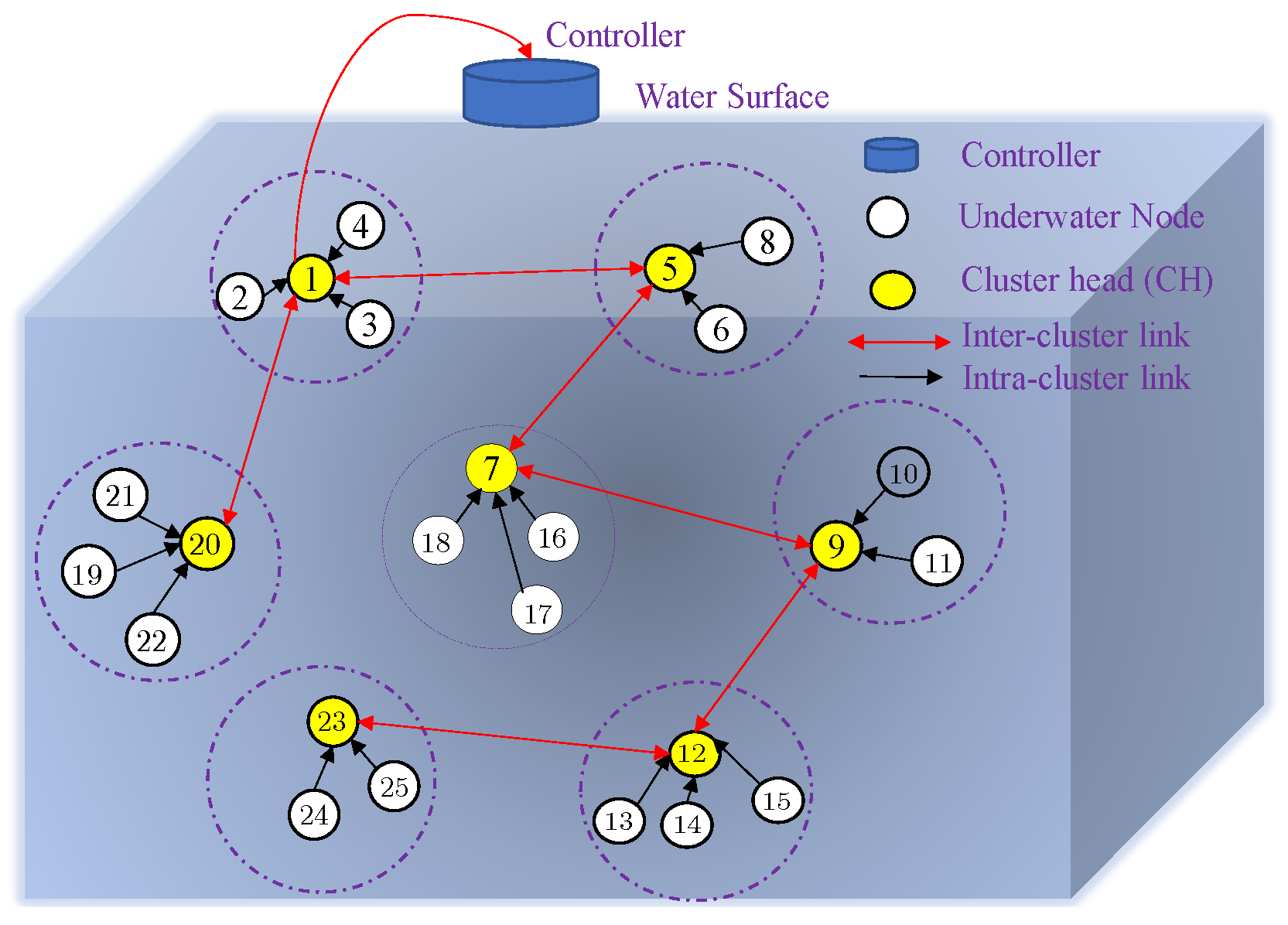

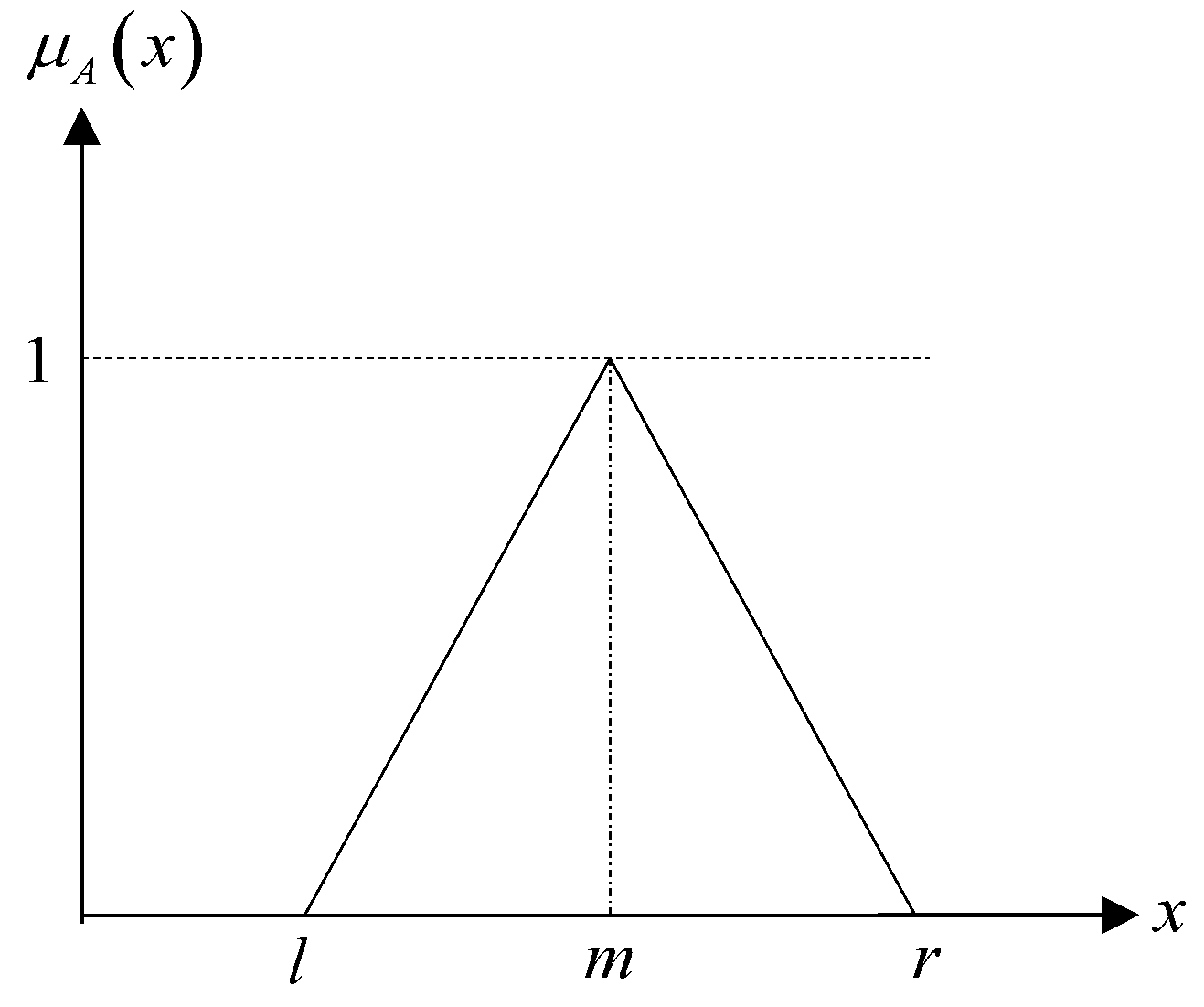

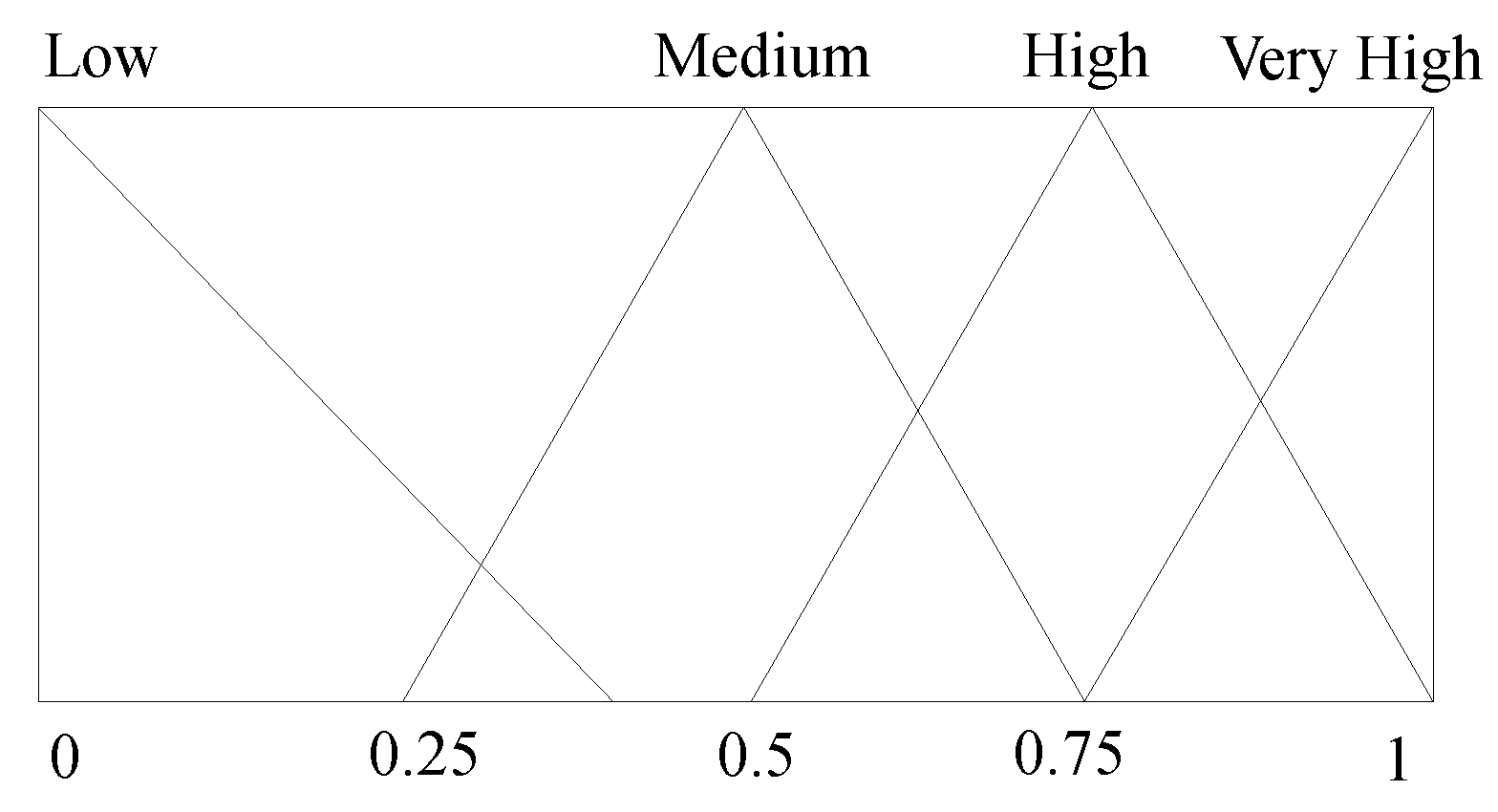
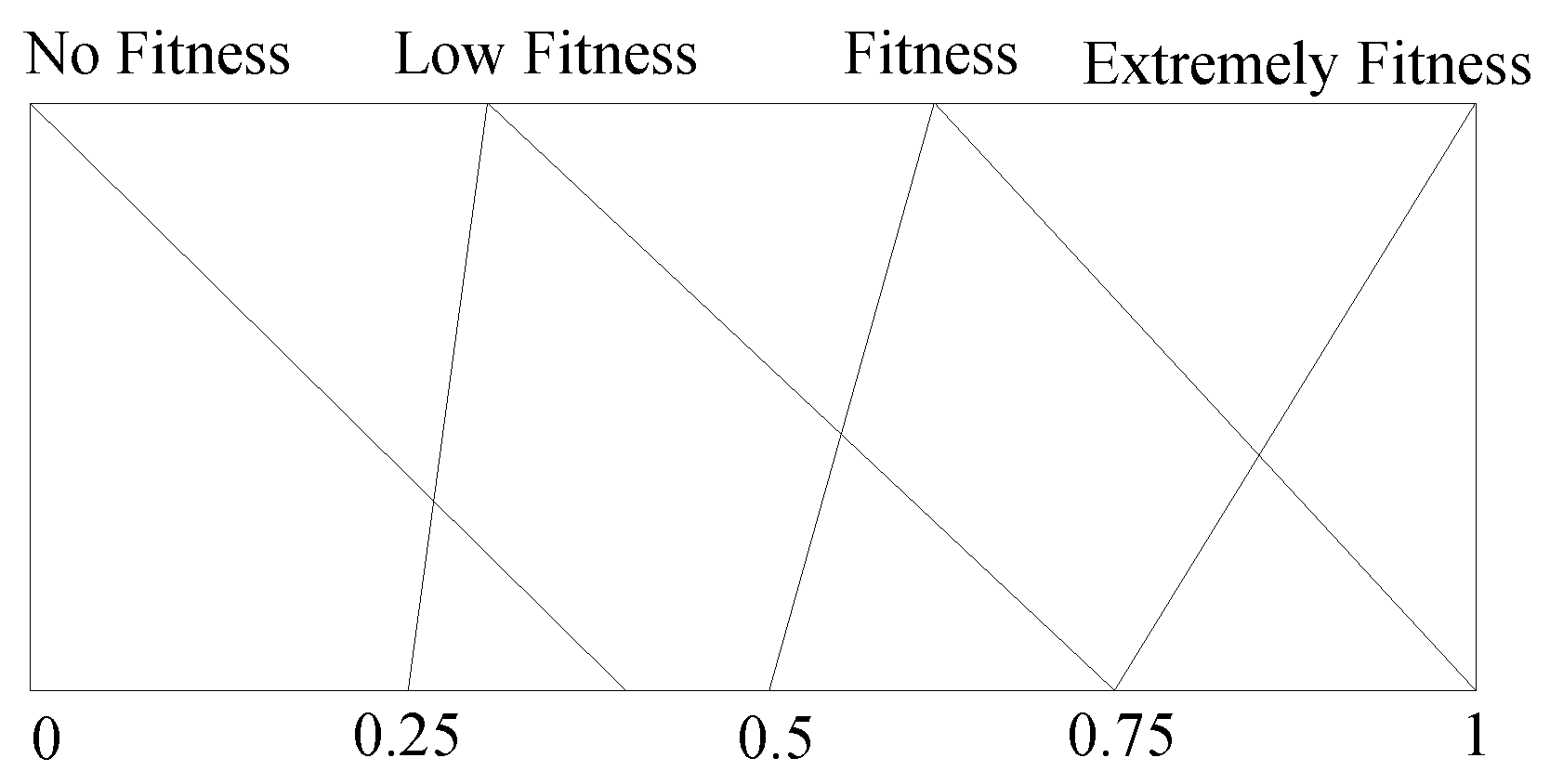
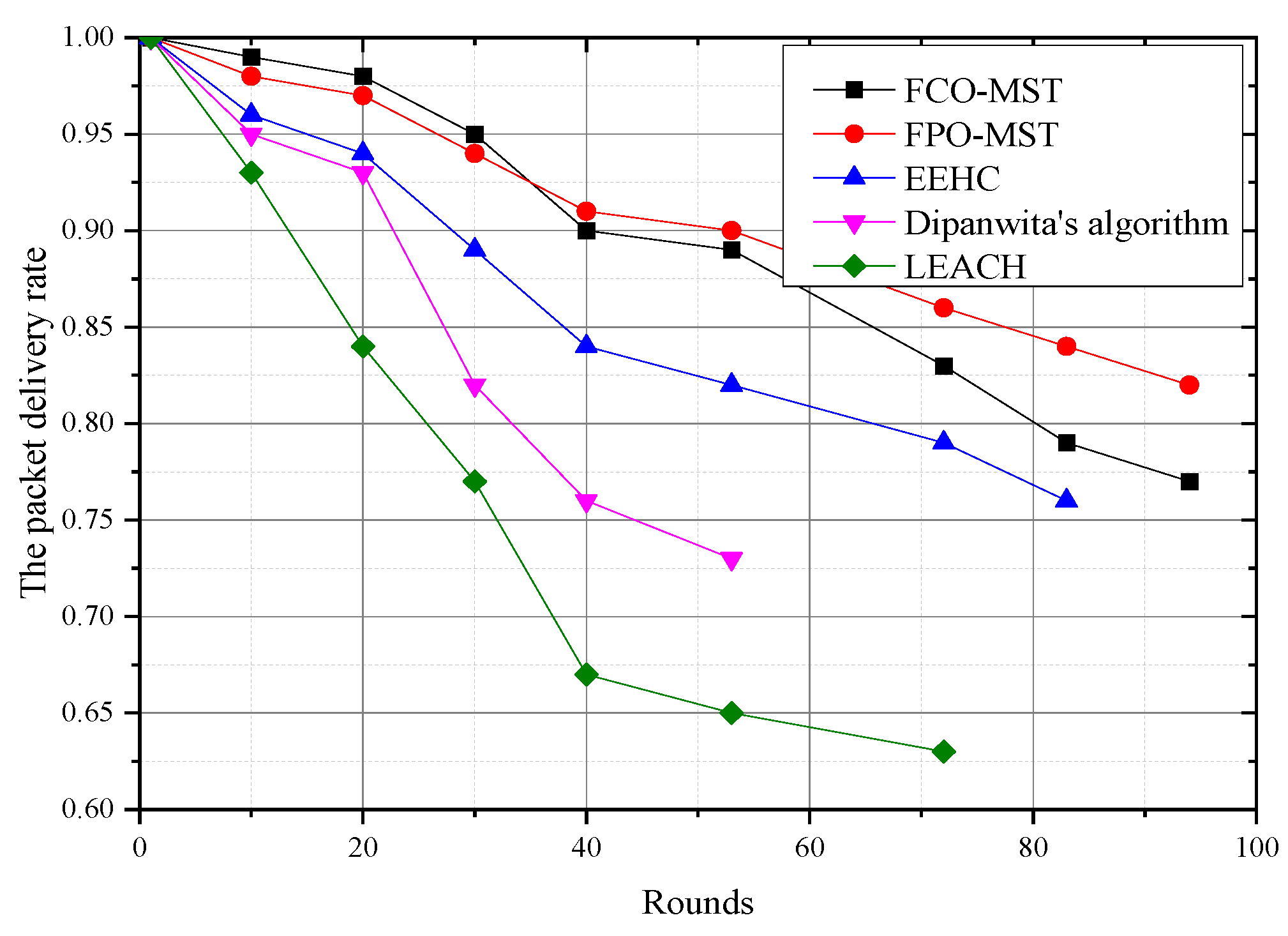

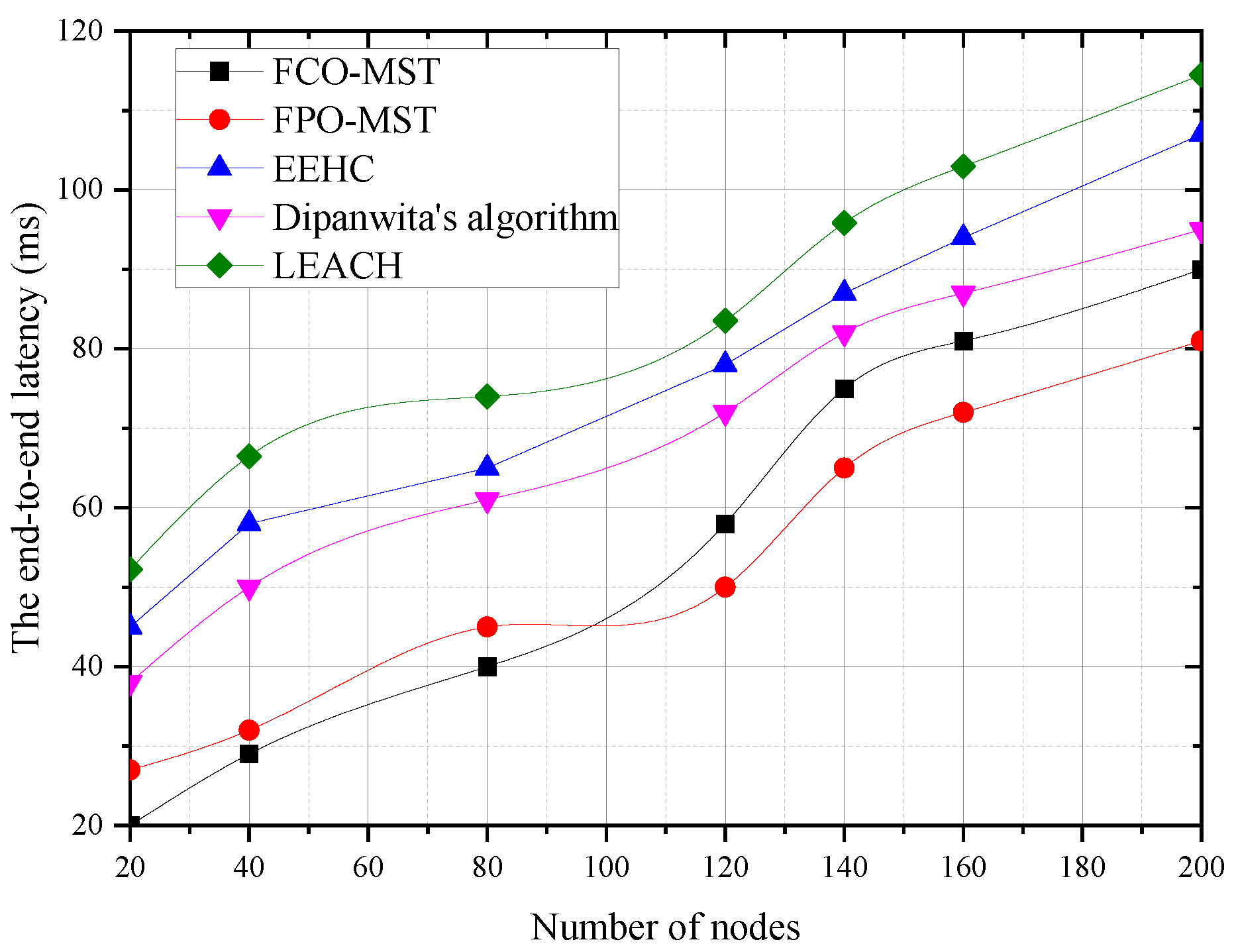
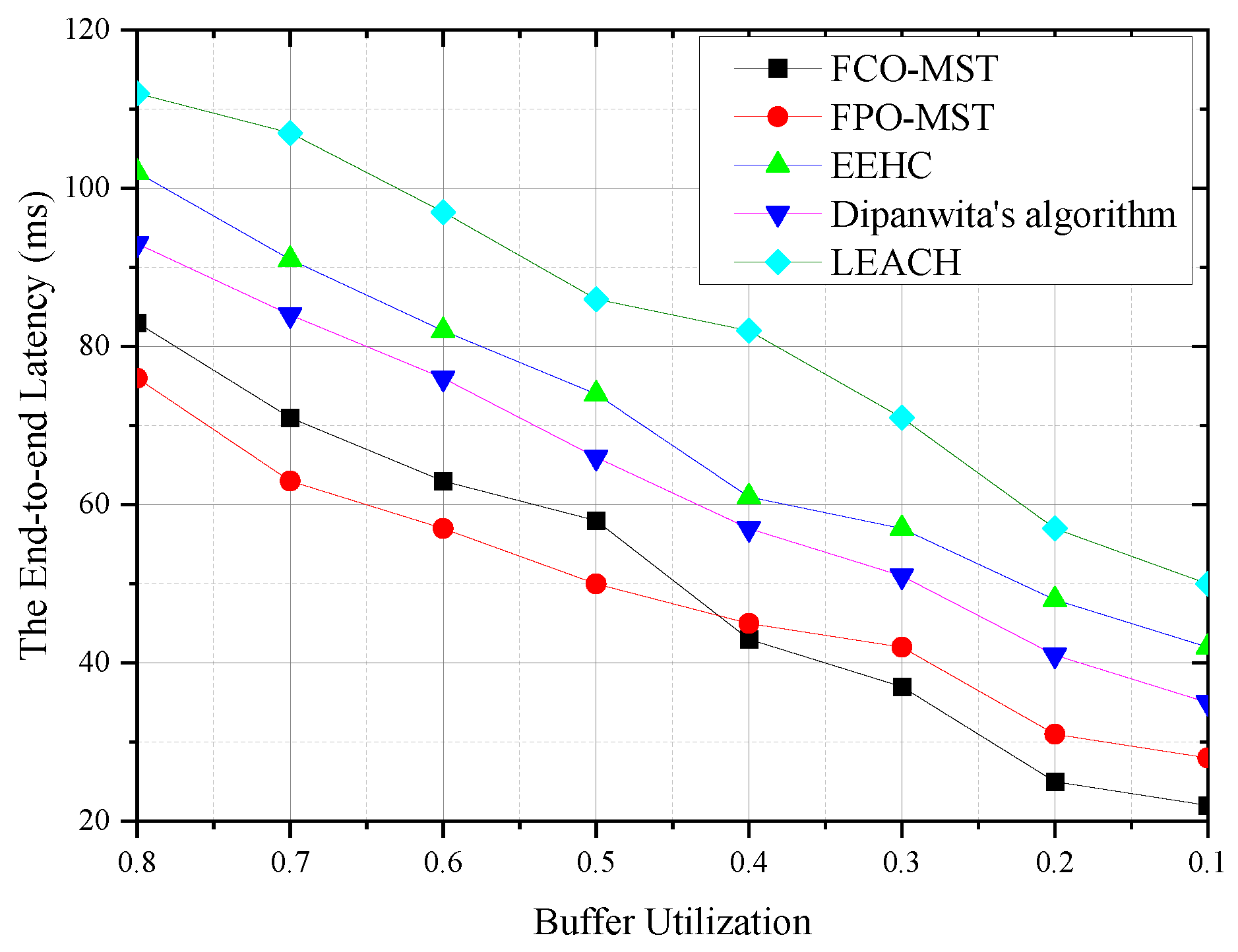
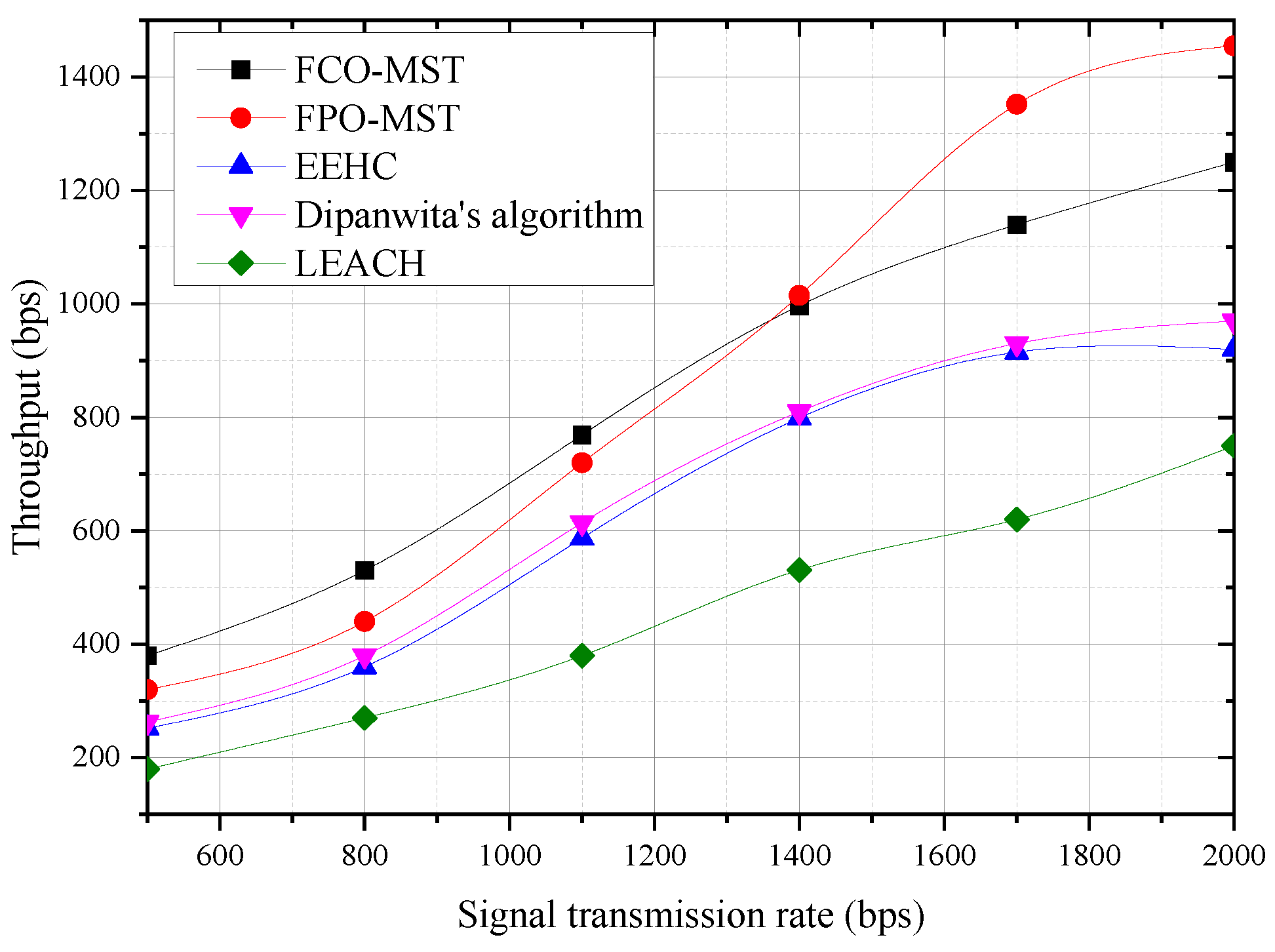
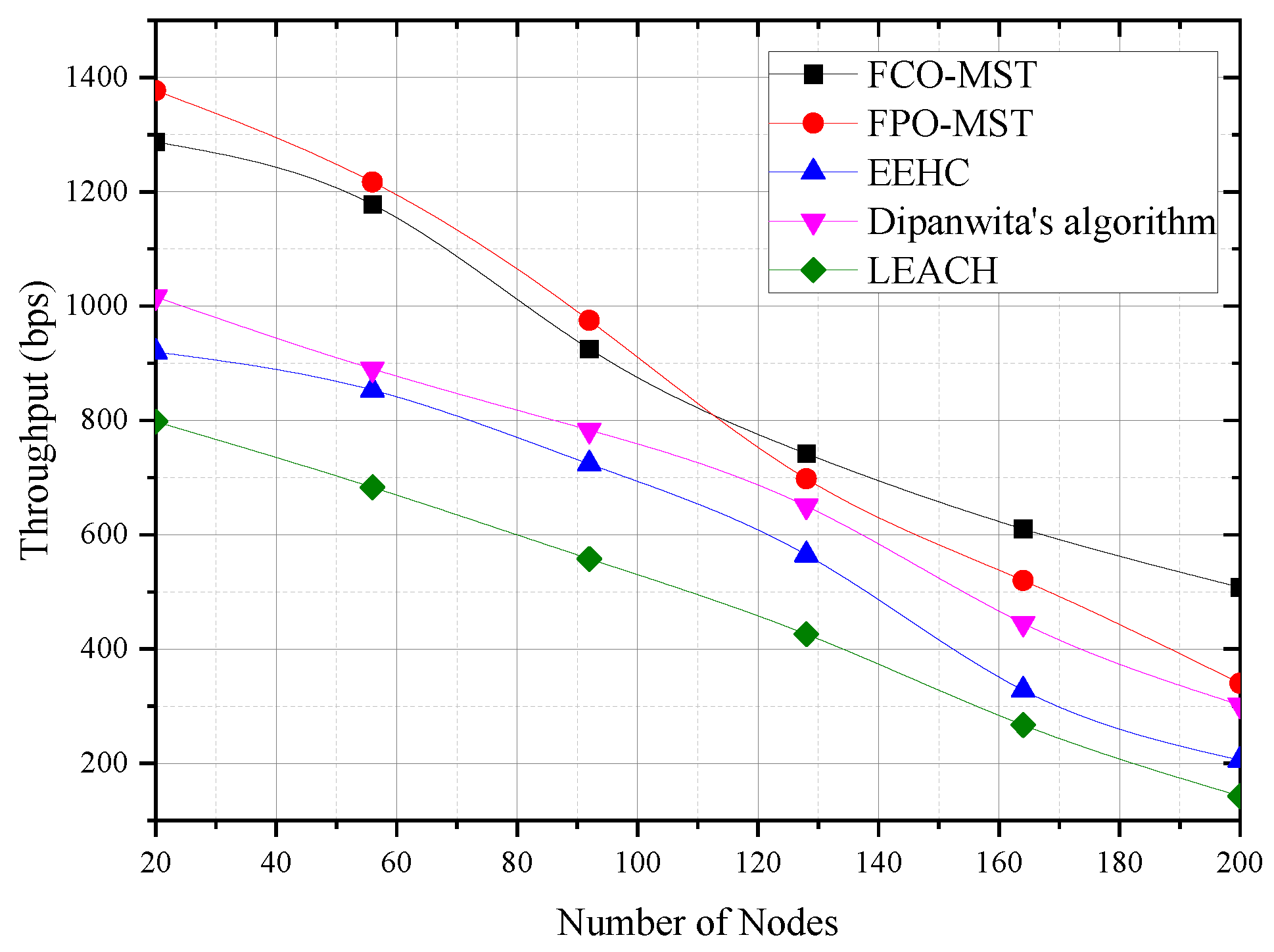
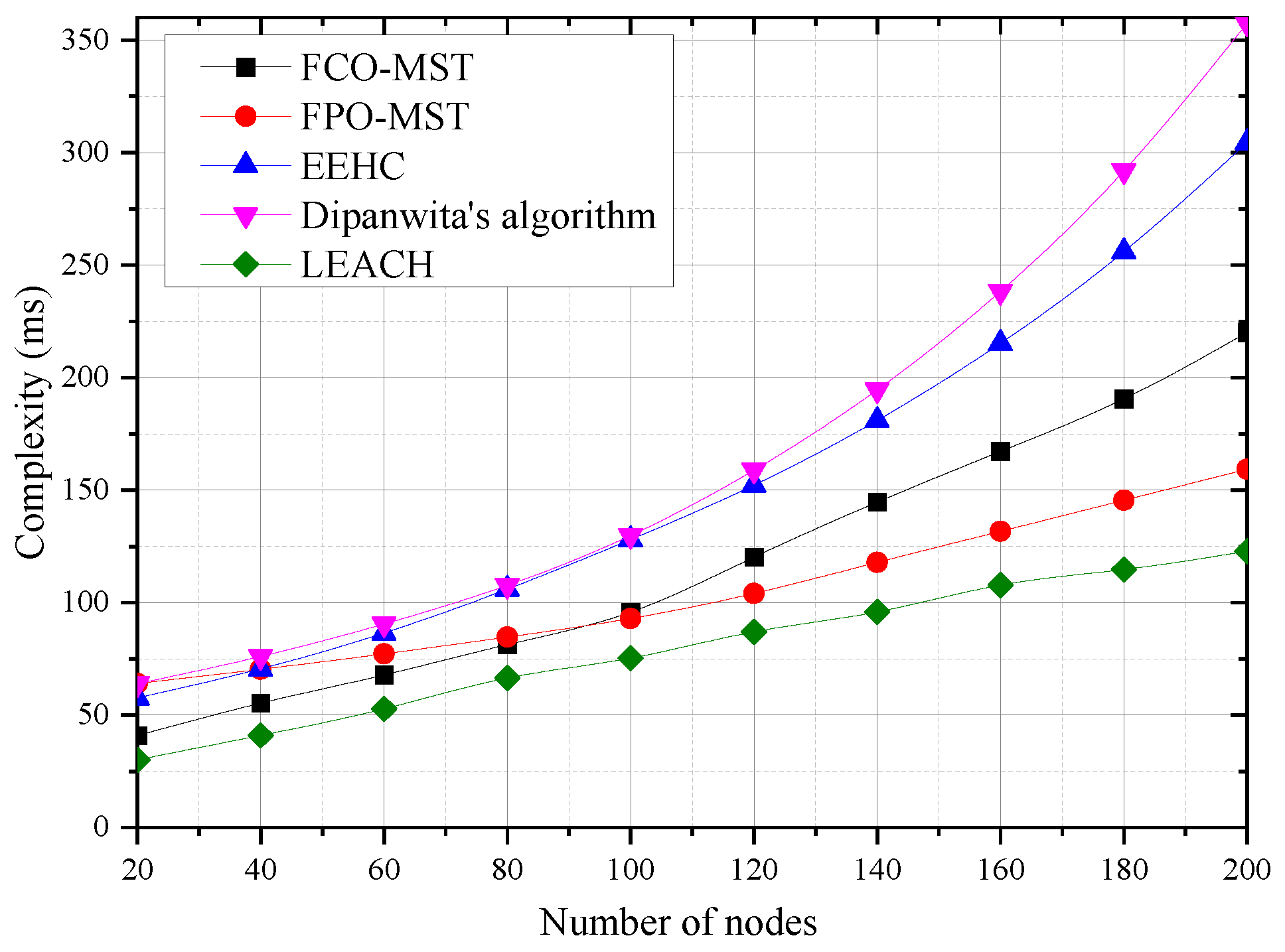
| ID of CHs | Expectations | ||
|---|---|---|---|
| Signal Strength | Residual Energy | Resource Occupancy | |
| CH5 | 0.2520 | 0.8420 | 0.2460 |
| CH7 | 0.2840 | 0.7040 | 0.2650 |
| CH12 | 0.1040 | 0.6850 | 0.2890 |
| Records | Factors | Path Weights | |||||
|---|---|---|---|---|---|---|---|
| CHi to CH5 | CHi to CH7 | CHi to CH12 | Optimal CH | ||||
| Item 1 | 0.3 | 0.34 | 0.36 | 0.22 | 0.28 | 0.23 | CH5 |
| Item 2 | 0.4 | 0.3 | 0.3 | 0.21 | 0.28 | 0.24 | CH5 |
| Item 3 | 0.33 | 0.28 | 0.39 | 0.22 | 0.28 | 0.25 | CH5 |
| Item 4 | 0.39 | 0.47 | 0.14 | 0.21 | 0.29 | 0.21 | CH5 or CH12 |
| Item 5 | 0.21 | 0.41 | 0.37 | 0.23 | 0.28 | 0.22 | CH12 |
| Item 6 | 0.18 | 0.49 | 0.33 | 0.23 | 0.28 | 0.2 | CH12 |
| Residual Energy | Resource Utilization | Fitness Value |
|---|---|---|
| Very low | Low | Low fitness |
| Very low | Medium | No fitness |
| Very low | High | No fitness |
| Very low | Very high | No fitness |
| Low | Low | Low fitness |
| Low | Medium | No fitness |
| Low | High | No fitness |
| Low | Very high | No fitness |
| Medium | Low | Fitness |
| Medium | Medium | Low fitness |
| Medium | High | No fitness |
| Medium | Very high | No fitness |
| High | Low | Extremely fitness |
| High | Medium | Fitness |
| High | High | Low fitness |
| High | Very high | No fitness |
| Very high | Low | Extremely fitness |
| Very high | Medium | Fitness |
| Very high | High | Low fitness |
| Very high | Very high | No fitness |
| Parameter | Value | Parameter | Value |
|---|---|---|---|
| Control channel model | Rayleigh Fading [40] | Data channel model | Rice Fading [41] |
| Noise type | Complex Gaussian | Underwater signal rate | 2000 bps |
| Carrier frequency | 10 kHz | Size of data Packet | 6400 bits |
| Size of control package | 200 bits | Power of clustering | 200 mW |
| Threshold of delay | 0.01 | Power of data communication | 300 mW |
| Threshold of PDR | 0.005 | Power of control communication | 500 mW |
| Threshold of reselecting CH | 0.35 | Power of the receiving message | 100 mW |
| Duration of the sequence | 5 ms | Power of sleep | 50 mW |
Disclaimer/Publisher’s Note: The statements, opinions and data contained in all publications are solely those of the individual author(s) and contributor(s) and not of MDPI and/or the editor(s). MDPI and/or the editor(s) disclaim responsibility for any injury to people or property resulting from any ideas, methods, instructions or products referred to in the content. |
© 2023 by the authors. Licensee MDPI, Basel, Switzerland. This article is an open access article distributed under the terms and conditions of the Creative Commons Attribution (CC BY) license (https://creativecommons.org/licenses/by/4.0/).
Share and Cite
Wang, J.; Feng, Q.; Ma, J.; Feng, Y. FL-SDUAN: A Fuzzy Logic-Based Routing Scheme for Software-Defined Underwater Acoustic Networks. Appl. Sci. 2023, 13, 944. https://doi.org/10.3390/app13020944
Wang J, Feng Q, Ma J, Feng Y. FL-SDUAN: A Fuzzy Logic-Based Routing Scheme for Software-Defined Underwater Acoustic Networks. Applied Sciences. 2023; 13(2):944. https://doi.org/10.3390/app13020944
Chicago/Turabian StyleWang, Jianping, Qigao Feng, Jianwei Ma, and Yikun Feng. 2023. "FL-SDUAN: A Fuzzy Logic-Based Routing Scheme for Software-Defined Underwater Acoustic Networks" Applied Sciences 13, no. 2: 944. https://doi.org/10.3390/app13020944
APA StyleWang, J., Feng, Q., Ma, J., & Feng, Y. (2023). FL-SDUAN: A Fuzzy Logic-Based Routing Scheme for Software-Defined Underwater Acoustic Networks. Applied Sciences, 13(2), 944. https://doi.org/10.3390/app13020944






